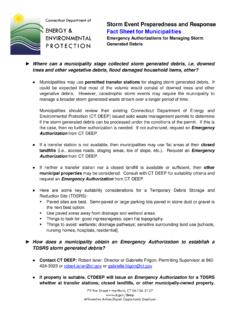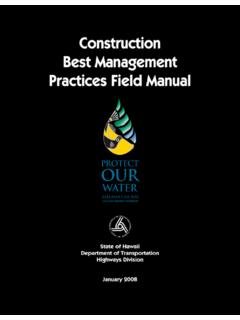Transcription of 16. Storm water drainage - WHO | World Health …
1 Health ASPECTS OF PLUMBING989916. Storm water drainageThere are three principal ways to dispose of rainwater from roofs, courtyards and paved areas: Storm water sewers, soakaways and collection in storage tanks. Storm water sewers, which may in some cases consist of open channels, are more common in urban or densely built-up areas, and they normally serve to take the drainage from highways as well as from Discharge into Storm water channels or pipesWhere a Storm water pipe or ditch exists within reasonable distance of the property on a building site, the drainage from the roof and from any paved or enclosed areas must be collected and discharged into the Storm water pipe or ditch. In many cases, the ditches or channels are laid alongside the road just outside the boundary of the property and are the responsibility of the highway authority, which may have its own connection requirements that should be incorporated into the plumbing code of practice.
2 For piped sewers, any connecting drains will need to comply with requirements similar to those that apply to drains carrying wastes to the soil sewer. The saddle or junction connection must be made under the direction of a licensed plumber or qualified person and must not obstruct the flow of the sewer or the drain. The drain itself must be laid to a self-cleansing gradient and must be properly jointed to prevent the access of tree roots or of the surrounding soil. However, the materials may not need to be of as high a quality and the drain may not need to undergo a test for into an open drainage channel may be through a pipe or through a subsidiary channel. Care must be taken to prevent erosion and damage to the channel lining. Subsidiary channels and pipes will usually be required to discharge in the direction of flow of the main channel at a level above that of the normal drainage flow. If the main channel is unlined and the discharge into it is through a pipe, a protective concrete apron may be required at the point of discharge.
3 Subsidiary channels should be laid to a self-cleansing gradient, but this, together with requirements relating to diameter, may be modified according to soil into Storm water sewers or channels must not contain any human waste, sullage water or other substances that may cause a nuisance or injury to Health . In tropical countries having a long dry season, small discharges, such as a drain from a single tap, may increase the risk of infestation because protozoans Health ASPECTS OF PLUMBING9899or other parasites may breed in shallow pools or waterlogged ground. Where a channel or drain may remain virtually dry for perhaps months at a time small discharges may cause considerable nuisance, especially if they contain deleteri-ous matter such as oil or grease. The authority may make special provisions to avoid this by requiring that a paved area where cars might be washed should be provided with a petrol, sand or oil trap and plate dangers must be balanced against the desirability of dealing with clean water discharges without requiring their being connected to human waste sew-ers.
4 Such instances as the drainage from air-conditioning units and of cooling water from a dairy or small industry, or the hosing down of a warehouse floor, should not call for disposal treatment, but the volume of water may be too great to be dealt with by Combined sewersSome sewerage authorities operate systems of combined sewers into which both sewage and rainwater may be admitted. These systems were installed in the past but are not currently recommended. Combined sewers are not economical because much greater flows must be provided for in the sewers and in the sewage disposal plant. These systems are also hazardous to Health because Storm over-flows must be provided to handle heavy downpours. Those overflows are neces-sary to relieve surcharge of the system at peak flows, and they may permit untreated sewage waste to discharge into open sewers are rarely installed today, but they are often found in congested areas of older cities where physical and financial constraints may prevent the laying of a second system of pipes to carry off rainwater.
5 Wastewater authorities provide separate sewerage facilities for new developments, as every additional connection to a combined sewer makes its ultimate replacement more difficult and SoakawaysRainwater from sloping roofs must be collected in gutters and carried to ground level by downpipes or downspouts. Flat roofs should be drained by vertical pipes and the drainage should be conveyed by pipe to a surface water sewer or to a suit-able soakaway. Except when a roof is thatched, gutters and downpipes or downspouts should always be considered essential because they prevent roof runoff falling from a height in concentrated sheets or streams, which can cause erosion close to the foundations of the building. If guttering cannot be installed a concrete path or apron should be laid immediately under the eaves, and should be sloped to carry the water away from the sizes of gutters and downpipes or downspouts will depend on the area of roof to be drained, the slope of the gutter and the intensity of rainfall expected.
6 To insist on guttering capable of dealing with the worst storms would be 16. Storm water DRAINAGEHEALTH ASPECTS OF PLUMBING100101unreasonably expensive in many areas, and would be of little overall benefit when the entire surrounding ground was being subjected to a downpour. The authority should calculate the average Storm intensity expected and fix their standards accordingly. Tables , and relate roof area, guttering slope and Storm intensity (Taylor & Wood 1982). These tables can be adapted to suit local conditions. The capacity of a range of Storm water drains is also shown, and may be applied to the drains connecting the lower ends of the downspouts with the surface water or not the use of soakaways is a practical option will depend to a great extent on the nature of the soil. Soakaways should be well clear of the building foundations, and should consist of holes deep enough to penetrate the subsoil, filled almost to the surface with hard material such as broken stone, concrete or brick that will not soften when wet.
7 Where the water table is high, it may be pref-erable to use shallow ditches filled with hard rubble instead of soakaway Rainwater tanksWhen rainwater is being stored for domestic use the tanks should be of water -tight construction, covered with material that is weatherproof, insectproof and verminproof, ventilated, and supplied with access for regular inspection and cleaning. There are many standards throughout the World . For more technical detail on this subject, please check your area for its standards. Rainwater storage tanks are a valuable supplement to mains supplied in arid areas and may even substitute for a mains supply. A system of gutters and collector piping must also be watertight, and the contents must be protected against pollution from dust and refuse blown by the wind, entry by birds and vermin, and mosquito breed-ing. If the rainwater is supplementary to a mains supply it may be lifted from the principal storage tank via a pump, from where it is piped to all fixtures.
8 If there is no mains drinking- water supply then water for all purposes will need to be taken from the rainwater storage tank. Strict precautions should be observed in such cases to maintain the quality of the stored water . A wash-out drain tap or diverter should be included in the collector pipe so that the first washings of the roof at the beginning of the rains can be run to waste (these washings will be contaminated with bird droppings, windblown dust, etc.). It is at this time that the storage tank should be given its annual cleaning, a process that is much easier if the tank is built in two sections that can be emptied and cleaned in Rainwater intensity and roof drainageThe variable factors in selecting the size of rainwater guttering are: the anticipated intensity of the rainfall; the slope at which the gutters are to be fixed; the area of the roof surface drained by each ASPECTS OF PLUMBING100101 From a practical point of view an upper limit of rainfall intensity must be assumed.
9 During downpours of higher than the assumed concentration, surplus rainwater will overflow the guttering but will add comparatively little to the general deluge. In Tables , and the maximum intensity has been assumed to be 100 millimetres (4 inches) per hour a high figure. In the code the figures would be recalculated for an intensity that is realistic for local slope of the gutter will be limited by the vertical gap between the eaves and the gutter at the lower end of the run. If this gap is much greater than the diameter of the channel small discharges will be blown clear of the gutter by quite moderate winds. A slope of 1% ( inch per 1 foot run) may be taken as an average, in which case an eaves length of 10 metres will result in a vertical gap of 10 centimetres. Lengths well over this will require two or more vertical downspouts with consequent increase in cost. In Table the roof areas that can be drained by gutters installed with slopes of , 1% and 2% are shown for purposes of comparison.
10 This table can be adjusted to allow for other slopes permitted under the code and can also be extended as needed to cover gutters of larger GUTTER SLOPES AND ROOF drainage : RAINFALL INTENSITY 100 mm PER HOUR Roof area drained with gutter slopes of: Guttering diameter (1 in 200) 1% (1 in 100) 2% (1 in 50) mm inches m ft m ft m ft 80 3 16 170 22 240 32 350 100 4 33 360 47 510 67 720 125 5 58 625 82 880 116 1 250 150 6 89 960 126 1 360 178 1 920 Source: Taylor & Wood 1982 (p. 156).The area of roof to be drained is calculated on the basis of the horizontal projection and not on the actual surface of a sloping roof. Table shows the maximum roof area that can be drained by five common sizes of vertical downspouts or leaders when the rainfall intensity is 100 millimetres (4 inches) per hour. These are suitable either to take the discharge from guttering or from flat roofs drained directly into these leaders. The figures should be adjusted to apply to discharges from storms of different intensity according to local conditions and Storm water DRAINAGEHEALTH ASPECTS OF PLUMBING102103 TABLE ROOF AREAS DRAINED BY VERTICAL DOWNSPOUTS: RAINFALL INTENSITY 100 mm PER HOUR Diameter of downspouts Roof area drained mm inches m ft 50 2 65 700 65 120 1 300 80 3 205 2 200 100 4 430 4 600 150 6 1 255 13 500 Source: Taylor & Wood 1982 (p.)















